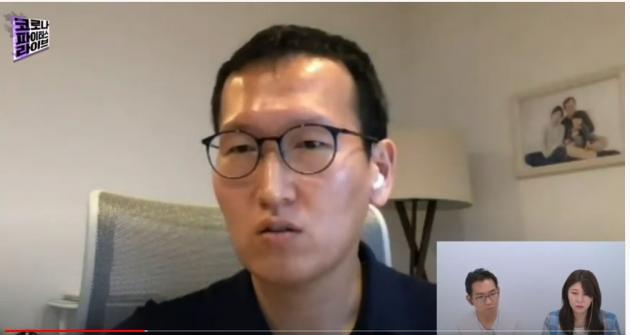California recently suffered a spike in Covid-19 confirmed cases but did not experience a healthcare service crisis because it had braced for the pandemic, a Korean doctor working in California said.
The U.S. reported 4.4 million Covid-19 confirmed cases and over 150,000 deaths as of Tuesday. California alone had 460,000 confirmed patients -- the largest number among states of the U.S.
However, California did not go through a medical crisis. Kang Hyun-seok, a professor at the Hematology and Oncology Department of University of California San Francisco (UCSF) School of Medicine, attributed California’s calm response to its preparedness.
On Friday, Kang shared the Covid-19 situation in California on a YouTube show, “Corona Fighters Live” by K-Healthlog, a channel operated by the Korean Doctors’ Weekly.
“On the outbreak of Covid-19, the California state started to manage resources pre-emptively. Even when UCSF Medical Center had no Covid-19 patient, hospital staff discussed how to triage patients and manage resources,” Kang said. “We even had a plan to make an outdoor camp in the park across the hospital.”
Even though UCSF Medical Center was managing Covid-19 patients, its use of beds increased, Kang said. “Now we have some empty beds. But we worry that the beds will be full soon,” he said.
UCSF Medical Center has 32 Covid-19 patients, and half of them are in the intensive care unit.
From the initial stage of the Covid-19 outbreak, the hospital obligated physicians and nurses to wear masks and restricted patients and guardians from entering the hospital. The hospital asked a patient with respiratory symptoms to go through an isolated testing facility. It separated the moving routes of patients from those of medical staff.

‘Authorities act quickly, but citizens shun wearing masks’
The southern part of California where a large number of people were confirmed with Covid-19, is gradually recovering, Kang said.
The average age of Covid-19 patients has come down to younger groups, and the number of seriously ill patients also went down, compared to April and May, he noted.
“As southern California has a large population, there are many hospitals. This is why the situation is relatively better here compared to New York,” he said.
He thought that the California state government was doing almost everything it could, and San Francisco, in particular, was taking the right measures.
However, the general public did not seek to follow the health authorities' guidelines, he said.
“The problem is that people do not follow the city government’s measures,” he said.
Kang said he saw many people staying close to each other at a park and hanging around without masks.
Young people seem to be less alert because they think they would not get much sick even if they get infected with Covid-19, he added.
Eligibility for Covid-19 test depends on insurance policies
Some people in California were put in a blind spot in terms of Covid-19 testing, Kang went on to say. He said those who do not have a clinic that they regularly go to or those without medical insurance found it hard to get Covid-19 testing.
“People who don’t have any clinic that they regularly visit are in trouble. There is no system for such people to get tested quickly,” Kang said. Usually, a local government is in charge of testing its residents. In San Francisco, a suspected patient can call up the city-sponsored testing facility to make a reservation for a test.
At first, there was a controversy over who should pay the testing cost. Later, the federal government said insurers had to pay, Kang said.
“The city supports the cost for people without health insurance policies, but this is possible only for financially sound local governments. So, there can be blind spots,” he said.
US hospitals expand ICU to overcome financial losses
Both U.S. and Korean hospitals suffered more losses due to Covid-19, but they acted differently about how to overcome the crisis.
Unlike Korea, the U.S. sets high reimbursement rates for intensive care. Thus, the U.S. hospitals were expanding intensive care units to reduce losses.
“In April and Many, many small hospitals closed business. As economic losses were enormous, the U.S. government also took some support measures,” he said.
Patients prefer telemedicine in US
As patients avoid visiting a hospital amid Covid-19, the U.S. hospitals expanded telemedicine. UCSF Medical Center also provides remote medical care, using Zoom, a video conferencing platform. The U.S. gives the same reimbursement rates to telemedicine and face-to-face care.
Kang said the government started encouraging non-face-to-face medical care as many patients missed the timing for treatment due to Covid-19.
The California state has enabled telemedicine for all Americans across the U.S. since the Covid-19 outbreak.
When a patient gets tested for Covid-19 at a clinical testing lab near home, the result gets delivered to a hospital. Then, the doctor can talk about the test result with the patient through videoconferencing, Kang explained.
“This system is so efficient that one-fourth of all medical care will be done remotely, even after Covid-19 ends,” he said.
Telemedicine does not require a hospital facility nor nursing assistants. Still, the hospital gets the same reimbursement rate, which is why hospitals prefer telemedicine, Kang noted.
Patients are also satisfied with telemedicine, he said. “A patient who has to come to a hospital through a seven-hour drive can get medical care at home. The patient was so happy to save the driving time,” he said.
Also, hospitals provide medical service for those who live in remote villages with a poor internet connection through phone calls, he added.

